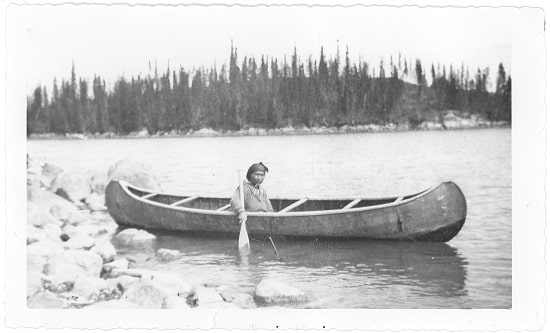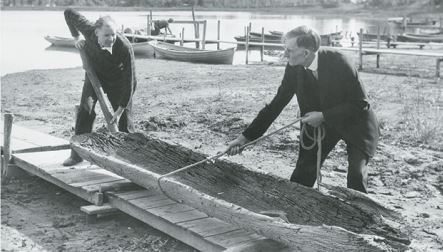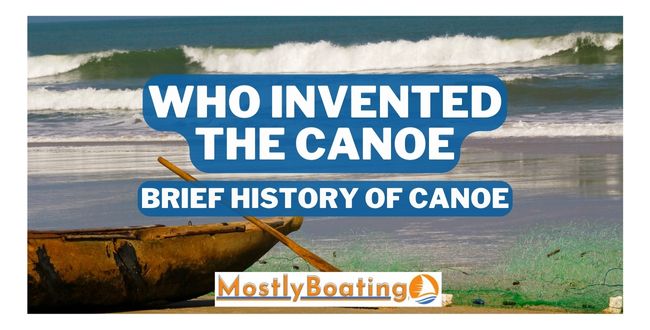The Canoe, a vessel that allows paddlers to explore nature and experience a sense of freedom, has been ingrained in various cultures and a beloved means of transportation and leisure activity for thousands of years.
The origins of the canoe can be traced back to the Stone Age, with its narrow and efficient design enabling smooth navigation through the water. However, determining who invented the canoe remains a challenging task due to its widespread use and appearance in ancient civilizations across the world.
How do we know who invented the canoe?
By exploring the history of the canoe, we gain a deeper understanding of its enduring legacy. Let’s explore the article that covers all the information about who invented canoes and other historical realities.
Who Invented the Canoes?
Canoes have been used by various cultures throughout history, so it is difficult to attribute their invention to a single individual. The exact origins of canoeing are not well-documented, as they predate written history. However, it is believed that indigenous peoples around the world independently developed the concept of using a canoe for transportation on water.
What civilization invented the canoe?
In the quest to uncover the origins of the canoe, archaeologists and researchers have made remarkable discoveries that shed light on the fascinating history of this ancient watercraft.

While the invention of canoes cannot be attributed to a specific civilization, canoes emerged independently in various ancient cultures across the world, with indigenous peoples in North America, Polynesians, and Vikings each making significant contributions.
What was the first known canoe?
Due to the canoe’s ancient existence pre-dating recorded history, a significant finding has provided valuable insights.
One notable discovery is the Pesse Canoe, unearthed in the Netherlands. This ancient canoe, estimated to be approximately ten thousand years old, is considered the oldest known boat ever found
Brief Canoe History
The history of canoes spans back thousands of years. Canoes have been integral to human civilizations across the world, providing a means of transportation, exploration, and survival.
From the Native American tribes in North America to the Polynesians navigating the vast Pacific Ocean, and the Vikings utilizing canoes for their voyages, each civilization contributed to the development and evolution of these remarkable watercraft.
Today, canoes continue to hold significance as a recreational activity and a symbol of exploration and freedom.
Why is it called a canoe?
The word “canoe” itself holds its own charm and history. Derived from the Arawakan language, spoken by indigenous peoples of the Caribbean and South America, the term “canoe” originally referred to a small, light boat made from a hollowed-out tree trunk. Over time, the term became widely adopted and used to describe similar vessels across different cultures and regions.
What were canoes used for in the past?
Throughout history, canoes have served a multitude of purposes. In indigenous cultures, canoes were essential for fishing, hunting, and transportation. They allowed for efficient movement across bodies of water, enabling communities to access resources and establish trade networks.
Has Canoeing been used as recreation in the past?
While canoes played a vital role in survival and sustenance, they also found a place in leisure activities. In many cultures, canoeing became a recreational pastime, with people taking to the water for enjoyment, relaxation, and sport. The thrill of paddling through calm waters or navigating rapids became a source of entertainment and adventure.
Important Individuals Who Made Significant Contributions to Canoe Development
The evolution of canoes, as we know them today, has been shaped by the remarkable contributions of visionary individuals throughout history. These pioneers played a pivotal role in refining canoes’ design, construction, and usage. One such notable figure is Barrister John Macgregor, an English-Scottish lawyer, writer, and sportsman.
Inspired by the ancient kayaks of the Inuits, Macgregor commissioned the construction of his first canoe in 1865, incorporating decked sailing canoes with masts and sails. His adventures on these canoes, chronicled in his books and lectures, ignited interest in canoeing as a recreational activity.
Pesse Canoe: The Oldest Known Canoe
When discussing the history of canoes, it is impossible to overlook the remarkable discovery of the Pesse Canoe. Unearthed in the Netherlands, the Pesse Canoe is believed to be the oldest known canoe, dating back approximately 10,000 years. Its excavation shed light on the early ingenuity of our ancestors and their mastery of boat building.

Where was the Pessey canoe found?
The remarkable Pesse Canoe considered the oldest known boat ever found, was discovered in the village of Pesse in the Netherlands. Unearthed in 1955, this ancient canoe dates back approximately ten thousand years and was crafted from a Scotch pine log using primitive tools.
How were the first canoes made – Prehistoric Design
The construction of prehistoric canoes required resourcefulness and craftsmanship. Early canoes were often made by hollowing out logs or using bark from trees. These natural materials provided strength and buoyancy while allowing for easy maneuverability. The skill and knowledge required to shape and carve these vessels demonstrate the resourcefulness of early humans.
How early did humans make canoes?
Humans began crafting canoes thousands of years ago, showcasing their ingenuity and adaptability. Though who invented the canoe is still mysterious, early evidence suggests that ancient civilizations created canoes as early as the Stone Age, utilizing materials like logs, bark, and reeds. These early watercraft allowed humans to navigate and explore waterways, marking the beginning of a rich history of canoeing.
Comparison of Modern and Traditional Canoes
As canoeing progressed, so did the materials and construction techniques used in building canoes. Modern canoes often incorporate lightweight materials such as fiberglass, Kevlar, or carbon fiber, providing enhanced performance and durability.
Traditional canoes, on the other hand, maintained their charm and continued to be crafted using natural materials like wood and bark, preserving the legacy of ancient designs.
Spread of Canoeing as a Global Sport
Over time, canoeing evolved from a practical means of transportation to a popular sport enjoyed worldwide. The sport gained recognition and popularity in the 19th century, and canoe clubs and associations were formed to promote the activity.
Today, canoes have become an integral part of various recreational and competitive activities. Whether it’s racing, whitewater rafting, touring, camping, freestyle paddling, or simply finding joy in the serene beauty of nature, canoes provide endless opportunities for adventure and relaxation.
History of Canoeing as a Sport and Olympics
Canoeing’s popularity as a sport led to its inclusion in the Olympic Games. The sport made its Olympic debut in 1936 with flatwater canoeing events for men. Over the years, the Olympic program expanded to include women’s events and various disciplines, showcasing the skill, strength, and determination of athletes on the global stage.
Canoeing Events and Top Canoeing Athletes
| Canoeing Even | Details | Top Canoeing Athletes |
Olympic Canoe Slalom | Held in the Summer Olympics, featuring | Michal Martikán (SVK) |
| Exciting and challenging races through whitewater | Jessica Fox (AUS) | |
| Courses | Lisa Carrington (NZL) | |
World Canoe Sprint | The premier sprint racing event, showcasing | Sebastian Brendel (GER) |
| Speed and endurance on calm water courses. | Lisa Carrington (NZL) | |
| Championships | Mathieu Goubel (FRA) | |
| Laurence Vincent-Lapointe (CAN) |
Amazing Historical Facts about Canoes
Digging deeper into the history of canoes reveals some intriguing facts:
- Native American tribes used canoes for travel, fishing, and trade, with each tribe coming up with its own designs and construction techniques.
- The Inuit people of the Arctic region used kayaks, a specialized type of canoe, for hunting in icy waters.
- The ancient Polynesians are believed to have navigated vast stretches of the Pacific Ocean using outrigger canoes, displaying remarkable seafaring skills.
- The birchbark canoe: developed by indigenous peoples in North America, was prized for its lightweight and navigational capabilities.
Canoes in Ocean Voyages
While canoes were primarily used for inland waterways, there are instances of remarkable oceanic voyages undertaken in canoes. For example, the Hokulea, a traditional Polynesian voyaging canoe, embarked on a historic journey across the Pacific Ocean, showcasing the navigational techniques and seafaring prowess of ancient cultures.
Longest Canoe Trip on Record
The longest recorded canoe trip is attributed to Verlen Kruger, an American adventurer. Kruger paddled over 28,000 miles, traversing the waterways of North America in multiple expeditions. His remarkable endurance and dedication to canoeing inspired many and set a record that remains unmatched.

Advanced and Technical Canoe Designs
In the pursuit of enhanced performance and functionality, canoe designs have evolved significantly. Today, advanced canoe structures feature streamlined hulls, adjustable seating systems, and improved stability.
Floating a Concrete Canoe
While it may seem counterintuitive, floating a concrete canoe is indeed possible. Concrete canoes, used in engineering competitions, are designed with specific materials and construction techniques to achieve buoyancy. These unique vessels combine the strength and durability of concrete with innovative design principles, showcasing the ingenuity and versatility of canoe engineering.
Wrapping Up – Who Invented the Canoe – Canoe History
The invention of the canoe cannot be attributed to a single individual or culture. Instead, canoes emerged independently in different parts of the world, showcasing the human instinct for exploration and the necessity to navigate waterways for survival.
Through the ages, canoes have enabled humans to explore, trade, fish, and compete. They have been integral to the development of civilizations and the preservation of cultural traditions.
It is understood that who invented the canoe remains unclear; prehistoric people developed canoes independently. But today, when we glide through serene lakes or tackle challenging rapids, the canoe continues to captivate individuals, embodying the spirit of human ingenuity and the timeless allure of the water. So, the next time you see a canoe gracefully slicing through the water, remember the fascinating history and the countless stories that lie beneath its surface.
FAQs
What kind of wood did Native Americans use for canoes?
Native Americans utilized various types of wood for canoe construction, depending on their geographical location. Birchbark canoes were prevalent in the northern regions, while tribes in the Pacific Northwest crafted canoes from cedar.
What does a canoe symbolize?
Canoes often symbolize adventure, exploration, and connection with nature. They represent the spirit of discovery and the ability to navigate through life’s challenges.
What was the importance of canoes in early civilization?
Canoes played a vital role in early civilizations by enabling transportation, trade, fishing, and exploration. They facilitated the expansion of communities and the exchange of goods and ideas.
Did the Aztecs invent the canoe?
The Aztecs, known for their advanced civilization in Mesoamerica, did not invent the canoe. Canoe-like vessels were present in various cultures across the world, and the Aztecs had their own unique forms of watercraft.
Why do canoes have holes?
Canoes often have holes, called scupper holes, which serve multiple purposes. These holes allow water to drain out of the canoe, preventing it from accumulating and adding weight. They also aid in stability by allowing excess water to escape, especially in rough waters.

Passionate freelance writer and certified boat captain, Sam brings his expertise to this pedal boating & Canoeing blog. With a knack for captivating storytelling and in-depth knowledge of boating regulations, he’s here to make your boating experience even more enjoyable and informed.
